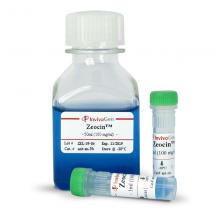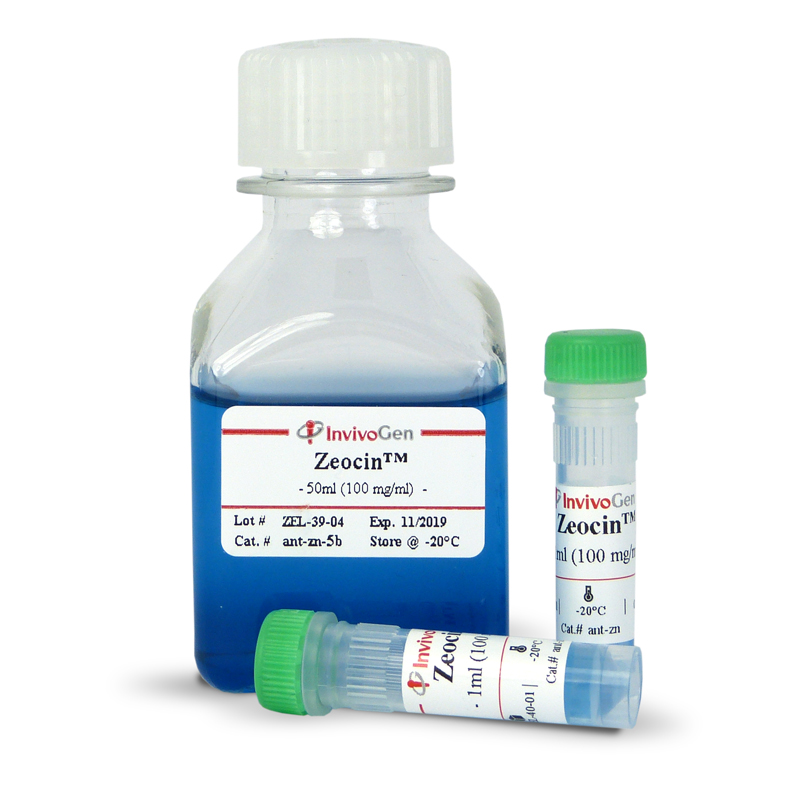Zeocin®
| Product | Unit size | Cat. code | Docs. | Qty. | Price | |
|---|---|---|---|---|---|---|
|
Zeocin® (solution) Selective antibiotic for the Sh ble gene |
Show product |
500 mg (5 x 1ml) 1g (10 x 1 ml) 5g (50 x 1 ml) 5 g (50 ml bottle) |
ant-zn-05
|
|
||
|
Zeocin® (powder) Selective antibiotic for the Sh ble gene |
Show product |
1 g (powder) 5 g (powder) |
ant-zn-1p
|
|
Zeocin® | Selection antibiotic: endotoxin tested, sterile reagent
InvivoGen is the sole worldwide producer of Zeocin®.
Zeocin® is a formulation of phleomycin D1, a copper-chelated glycopeptide antibiotic produced by a proprietary strain Streptomyces CL990. Zeocin® causes cell death by intercalating into DNA and cleaving it.
The action of Zeocin® is effective on most aerobic cells. Therefore, Zeocin® is a popular and effective antibiotic for the selection of vectors bearing the Sh ble gene in a variety of cells types (bacteria, eukaryotic microorganisms, plant and animal cells).
Resistance to Zeocin® is conferred by the Sh ble gene product from Streptoalloteichus hindustanus, which inactivates Zeocin® upon binding to the antibiotic [1-3].
Sh ble is a small 370bp-sized gene and is carried in a number of InvivoGen’s vectors.
Typically, mammalian cells are sensitive to Zeocin® concentrations of 50-400 µg/ml, and bacteria to 25 µg/ml.
For research use only
References:
1. Drocourt D. et al., 1990. Cassettes of the Streptoalloteichus hindustanus ble gene for transformation of lower and higher eukaryotes to phleomycin resistance. Nucl. Acids. Res. 18: 4009.
2. Gatignol A. et al., 1988. FEBS Letters. 230: 171-5.
3. Dumas P. et al., 1994. Embo J. 242 (5) 595-601.
Specifications
Product concentration: 100 mg/ml in solution
CAS number: 11006-33-0
Quality Control: Each lot is thoroughly tested to ensure the absence of lot-to-lot variation.
Endotoxin level: < 1 EU/mg
Physicochemical characterization: HPLC, pH, appearance
Cell-culture tested: potency validated in Zeocin®-sensitive and Zeocin®-resistant mammalian cell lines
Non-cytotoxicity of trace contaminants: absence of long-term effects confirmed in Zeocin®-resistant cells
Back to the topContents
Zeocin® is supplied as a sterile filtered blue solution at 100 mg/ml in HEPES buffer.
This product is available in three pack sizes:
- ant-zn-1: 10 x 1 ml (1 g)
- ant-zn-5: 50 x 1 ml (5 g)
- ant-zn-5b: 1 x 50 ml (5 g)
Zeocin® is also supplied as a blue powder:
- ant-zn-1p: 1 x 1 g
- ant-zn-5p: 1 x 5 g
![]() Zeocin® is shipped at room temperature.
Zeocin® is shipped at room temperature.
![]() Upon receipt it should be stored at 4°C or -20°C.
Upon receipt it should be stored at 4°C or -20°C.
![]() Zeocin® is a harmful compound. Refer to safety data sheet for handling instructions.
Zeocin® is a harmful compound. Refer to safety data sheet for handling instructions.
Details
WORKING CONCENTRATIONS
Zeocin® is normally used at a concentration of 100 μg/ml, a 1000-fold dilution from the stock solution. However, the optimal concentration needs to be determined for your cells.
Suggested concentrations of Zeocin® for selection in some examples of mammalian cells are listed below:
|
Cell line |
Medium |
Zeocin® conc |
References |
|---|---|---|---|
|
B16 (Mouse melanocytes) |
RPMI |
20-250 μg/ml |
1-3 |
|
CHO (Chinese hamster ovarian cells) |
DMEM |
100-500 μg/ml |
1, 4, 5 |
|
COS (Monkey kidney cells) |
DMEM |
100-400 μg/ml |
6, 7 |
| HEK293 (Human embryonic kidney cells) | DMEM | 100-400 μg/ml | 8, 9 |
| HeLa (Human uterine cells) | DMEM | 50-100 μg/ml | 10, 11 |
| J558L (Mouse melanocytes) | RPMI | 400 μg/ml | 12 |
| MCF-7 (Human breast adenocarcinoma cells) | DMEM | 100-400 μg/ml | 13, 14 |
| MEFs (Mouse embryonic fibroblasts) | DMEM | 200-400 μg/ml | 15, 16 |
| THP-1 (Human monocytes) | RPMI | 200 μg/ml | 17 |
References:
1. Bouayadi K. et al., 1997. Overexpression of DNA polymerase beta sensitizes mammalian cells to 2’,3’ deoxycytidine and 3’-azido-3’-deoxythymidine. Cancer Res. 57: 110-116.
2 Hirose Y. et al., 2012. Inhibition of Stabilin-2 elevates circulating hyaluronic acid levels and prevents tumor metastasis. PNAS, 109: 4263 - 4268.
3. Fan H. et al., 2012. Intracerebral CpG immunotherapy with carbon nanotubes abrogates growth of subcutaneous melanomas in mice. Clin Cancer Res.18(20):5628-38.
4. Li F. et al., 1996. Post-translational modifications of recombinant P-selection glycoprotein ligand-1 required for binding to P- and E- selection. J. Biol. Chem. 271: 3255-3264.
5. Ogura T. et al., 2004. Resistance of B16 melanoma cells to CD47-induced negative regulation of motility as a result of aberrant N-glycosylation of SHPS-1. J Biol Chem. 279(14):13711-20.
6. Saxena A. et al., 2002. H2, the minor subunit of the human asialoglycoprotein receptor, trafficks intracellularly and forms homo-oligomers, but does not bind asialo-orosomucoid. J Biol Chem. 277(38):35297-304.
7. Kanamori A. et al., 2002. Distinct sulfation requirements of selectins disclosed using cells that support rolling mediated by all three selectins under shear flow. L-selectin prefers carbohydrate 6-sulfation totyrosine sulfation, whereas p-selectin does not. J Biol Chem. 277(36):32578-86.
8. Ahmed et al., 2013. TRIF-mediated TLR3 and TLR4 signaling is negatively regulated by ADAM15. J Immunol. 190(5):2217-28.
9. Büllesbach EE. & Schwabe C., 2006. The mode of interaction of the relaxin-like factor (RLF) with the leucine-rich repeat G protein-activated receptor 8. J Biol Chem. 281(36):26136-43.
10. Mesnil M. et al., 1996. Bystander killing of cancer cells by herpes simplex virus thymidine kinase gene is mediated by connexins. PNAS 93(5):1831-5.
11. Maszczak-Seneczko D. et al., 2013. UDP-N-acetylglucosamine transporter (SLC35A3) regulates biosynthesis of highly branched N-glycans and keratan sulfate. J Biol Chem. 288(30):21850-60.
12. Cedeno-Laurent F. et al., 2010. Development of a nascent galectin-1 chimeric molecule for studying the role of leukocyte galectin-1 ligands and immune disease modulation. J Immunol. 185(8):4659-72.
13. Kim HS. et al., 2004. Insulin-like growth factor-binding protein 3 induces caspase-dependent apoptosis through a death receptor-mediated pathway in MCF-7 human breast cancer cells. Cancer Res. 64(6):2229-37.
14. List HJ. et al., 2001. Ribozyme targeting demonstrates that the nuclear receptor coactivator AIB1 is a rate-limiting factor for estrogen-dependent growth of human MCF-7 breast cancer cells. J Biol Chem. 276(26):23763-8.
15. Waak J. et al., 2009. Oxidizable residues mediating protein stability and cytoprotective interaction of DJ-1 with apoptosis signal-regulating kinase 1. J Biol Chem. 284(21):14245-57.
16. Maue A. et al., 2013. The polysaccharide capsule of Campylobacter jejuni modulates the host immune response. Infect Immun. 81(3):665-72
FAQs
Is the Zeocin® you provide hydrochloric or sulfate?
We supply hydrochloric Zeocin®.
Is Zeocin® photosensitive?
No, Zeocin® is not photosensitive.
Is Zeocin® pH sensitive?
Zeocin® will undergo irreversible denaturation at a low and high pH (<6 and >8) or in the presence of a weak oxidant.
What buffer can be used to dilute Zeocin® to make intermediate working solutions?
Further dilutions should be performed in sterile water to create an intermediate working solution.
What is the concentration of HEPES buffer used to reconstitute Zeocin®?
The concentration of HEPES buffer used to reconstitute Zeocin® is 5 g/L.
What is the preferred storage method for Zeocin®?
Zeocin® is shipped at room temperature. Upon receipt, it should be stored at 4°C for short term storage or -20°C for long term storage.
Avoid repeated freeze-thaw cycles.
The expiry date is specified on the product label.
For Zeocin® powder, once resuspended at 100 mg/ml, it can be stored at 4°C for 12 months or -20 °C for 18 months.
For Zeocin® solution, once opened it remains stable for 1 year at -20°C providing you avoid repeated freeze-thaw cycles, and it can be kept at 4°C for 3 months provided it is kept in sterile conditions.
What is the selection concentration of Zeocin® in mammalian cells?
The working concentration of Zeocin® in mammalian cell lines varies between 50 - 400 μg/ml, with a few reported cases of its use at lower (i.e. 20 μg/ml) and higher (i.e. 1000 μg/ml) concentrations. In an initial experiment we recommend to determine the optimal concentration of Zeocin® required to kill your host cell line. For more detailed information, please refer to the technical data sheet for this product.
What is the selection concentration of Zeocin® in E. coli?
Zeocin-resistant transformants are selected in low salt LB agar supplemented with 25 μg/ml of Zeocin®.
Important: Do not use an E. coli recipient strain that contains the Tn5 transposable element (i.e. MC1066). Tn5 encodes a bleomycin-resistance gene that will confer resistance to Zeocin®.






